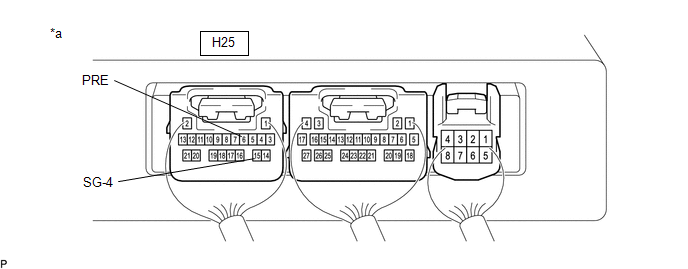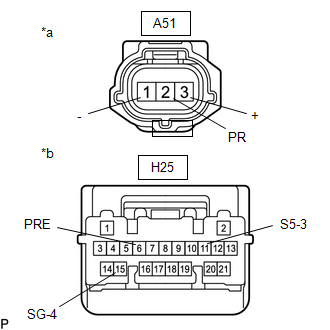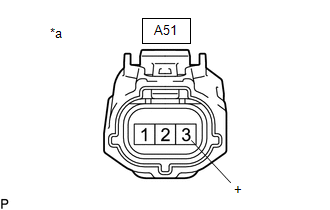Toyota Yaris: Air Conditioning Pressure Sensor / On-vehicle Inspection
ON-VEHICLE INSPECTION
PROCEDURE
1. INSPECT AIR CONDITIONING PRESSURE SENSOR
(a) Check the wire harness.
(1) Disconnect the A51 air conditioner pressure sensor connector.
(2) Disconnect the H25 air conditioning amplifier assembly connector.
| (3) Measure the resistance according to the value(s) in the table below. Standard Resistance:
If the resistance is not as specified, repair the wire harness. |
|
(4) Reconnect the H25 air conditioning amplifier assembly connector.
(5) Turn the ignition switch ON (IG).
| (6) Measure the voltage according to the value(s) in the table below. Standard Voltage:
If the voltage is not as specified, repair the wire harness or replace air conditioning amplifier assembly. |
|
(b) Check the air conditioner pressure sensor.
(1) Connect the connector to the A51 air conditioner pressure sensor connector.
(2) Install a manifold gauge set.
(3) Turn the A/C switch ON.
(4) Measure the voltage according to the value(s) in the table below.

| *a | Component with harness connected (Air Conditioning Amplifier Assembly) | - | - |
Standard Voltage:
| Tester Connection | Condition | Specified Condition |
|---|---|---|
| H25-6 (PRE) - H25-15 (SG-4) | Refrigerant pressure: Normal pressure (less than 3025 kPa (30.8 kgf/cm2, 439 psi) and more than 176 kPa (1.8 kgf/cm2, 26 psi)) | 0.74 to 4.61 V |
HINT:
Check from the rear of the connector while it is connected to the air conditioning amplifier assembly.
If the voltage is not as specified, replace the air conditioner pressure sensor.
 Components
Components
C..
 Removal
Removal
REMOVAL PROCEDURE 1. RECOVER REFRIGERANT FROM REFRIGERATION SYSTEM Click here
2. REMOVE AIR CONDITIONER PRESSURE SENSOR (a) Disconnect the connector...
Other information:
Toyota Yaris XP210 (2020-2026) Owner's Manual: Shift-Lock System
The shift-lock system prevents shifting out of P unless the brake pedal is depressed. To shift from P: Depress and hold the brake pedal. Start the engine. Press and hold the lock-release button. Move the selector lever. When the ignition is switched to ACC or the ignition is switched off, the selector lever cannot be shifted from P...
Toyota Yaris XP210 (2020-2026) Owner's Manual: Foot Brake
This vehicle has power-assisted brakes that adjust automatically through normal use. Should power-assist fail, you can stop by applying greater force than normal to the brake pedal. But the distance required to stop will be greater than usual. WARNING Do not coast with the engine stalled or turned off, find a safe place to stop Coasting with the engine stalled or turned off is dangerous...
Categories
- Manuals Home
- Toyota Yaris Owners Manual
- Toyota Yaris Service Manual
- Engine & Hybrid System
- G16e-gts (engine Mechanical)
- How to use USB mode
- New on site
- Most important about car
Fuel-Filler Lid and Cap
WARNING
When removing the fuel-filler cap, loosen the cap slightly and wait for any hissing to stop, then remove it
Fuel spray is dangerous. Fuel can burn skin and eyes and cause illness if ingested. Fuel spray is released when there is pressure in the fuel tank and the fuel-filler cap is removed too quickly.


